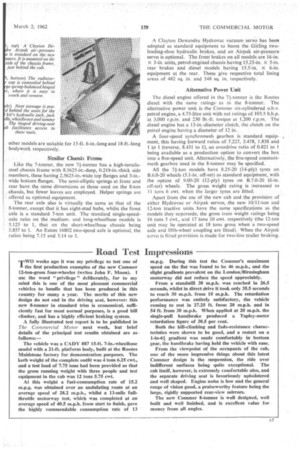Road Test Impressions
Page 71

If you've noticed an error in this article please click here to report it so we can fix it.
TWO weeks ago it was my privilege to test one of the first production examples of the new Commer 12-ton-gross four-wheeler (writes John F. Moon).
use the word " privilege" deliberately, for to my mind this is one of the most pleasant commercial vehicles to handle that has been produced in this country for many a year. The merits of this new design do not end in the driving seat, however: this new 8-tonner in standard trim is economical, sufficiently fast for most normal purposes, is a good hill climber, and has a highly efficient braking system.
A fully illustrated test report is to be published in The Commercial Motor next week, but brief details of the principal test results obtained are as follows:— The vehicle was a CADS' 887 15-ft, 7-in.-wheelbase model with a 21-ft. platform body, built at the Rootes Maidstone factory for demonstration purposes. The kerb weight of the complete outfit was 4 tons 6.25 cwt., and a test load of 7.75 tons had been provided so that the gross running weight with three people and tesl equipment in the cab was 12 tons 5.75 cwt.
At this weight a fuel-consumption rate of 15.2 m.p.g. was obtained over an undulating route at an average speed of 28.2 m.p.h., whilst a 13-mile fullthrottle motorway test, which was completed at an average speed of 40.5 m.p.h. from start to finish, gave the highly commendable consumption rate of 13
m.p.g. During this test the Commer's maximum speed on the flat was found to be 46 m.p.h., and the slight gradients prevalent on the London/Birmingham motorway did not reduce the speed appreciably.
From a standstill 30 m.p.h. was reached in 26.5 seconds, whilst in direct drive it took only 35.5 seconds to reach 30 m.p.h. from 10 m.p.h. The retardation performance was entirely satisfactory, the vehicle coming to rest in 27.25 ft. from 20 m.p.h. and in 59 ft. from 30 m.p.h. When applied at 20 m.p.h. the single-pull handbrake produced a Tapley-meter retardation figure of 30.5 per cent.
Both the hill-climbing and fade-resistance characteristics were shown to be good, and a restart on a 1-in-61 gradient was made comfortably inbottom gear, the handbrake having held the vehicle with ease.
From the viewpoint of the occupants of the cab, one of the more impressive things about this latest Commer design is the suspension, the ride over indifferent surfaces being quite exceptional. The cab itself, however, is extremely comfortable also, and the separate driving seat is luxuriously upholstered and well shaped. Engine noise is low and the genera/ range of vision good, a praiseworthy feature being the large, rigidly supported rear-view mirrors.
The new Commer 8-tonner is well designed, well built and well finished, and is excellent value for money from all angles.




















































































































































